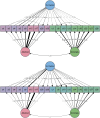The Wise Mind Balances the Abstract and the Concrete
- PMID: 38974582
- PMCID: PMC11226238
- DOI: 10.1162/opmi_a_00149
The Wise Mind Balances the Abstract and the Concrete
Abstract
We explored how individuals' mental representations of complex and uncertain situations impact their ability to reason wisely. To this end, we introduce situated methods to capture abstract and concrete mental representations and the switching between them when reflecting on social challenges. Using these methods, we evaluated the alignment of abstractness and concreteness with four integral facets of wisdom: intellectual humility, open-mindedness, perspective-taking, and compromise-seeking. Data from North American and UK participants (N = 1,151) revealed that both abstract and concrete construals significantly contribute to wise reasoning, even when controlling for a host of relevant covariates and potential response bias. Natural language processing of unstructured texts among high (top 25%) and low (bottom 25%) wisdom participants corroborated these results: semantic networks of the high wisdom group reveal greater use of both abstract and concrete themes compared to the low wisdom group. Finally, employing a repeated strategy-choice method as an additional measure, our findings demonstrated that individuals who showed a greater balance and switching between these construal types exhibited higher wisdom. Our findings advance understanding of individual differences in mental representations and how construals shape reasoning across contexts in everyday life.
Keywords: construal; measurement; mental representations; perspective-taking; wisdom.
© 2024 Massachusetts Institute of Technology.
Conflict of interest statement
Competing Interests: The authors declare no conflict of interests.
Figures



Similar articles
-
"Wisdom, bias, and balance: Toward a process-sensitive measurement of wisdom-related cognition": Correction to Brienza et al. (2017).J Pers Soc Psychol. 2018 Dec;115(6):943. doi: 10.1037/pspp0000234. J Pers Soc Psychol. 2018. PMID: 30550320
-
Wisdom, bias, and balance: Toward a process-sensitive measurement of wisdom-related cognition.J Pers Soc Psychol. 2018 Dec;115(6):1093-1126. doi: 10.1037/pspp0000171. Epub 2017 Sep 21. J Pers Soc Psychol. 2018. PMID: 28933874
-
Training for Wisdom: The Distanced-Self-Reflection Diary Method.Psychol Sci. 2021 Mar;32(3):381-394. doi: 10.1177/0956797620969170. Epub 2021 Feb 4. Psychol Sci. 2021. PMID: 33539229
-
Wisdom is a social-ecological rather than person-centric phenomenon.Curr Opin Psychol. 2020 Apr;32:66-71. doi: 10.1016/j.copsyc.2019.07.010. Epub 2019 Jul 15. Curr Opin Psychol. 2020. PMID: 31400714 Review.
-
Wisdom in Context.Perspect Psychol Sci. 2017 Mar;12(2):233-257. doi: 10.1177/1745691616672066. Perspect Psychol Sci. 2017. PMID: 28346113 Review.
References
-
- Adler, S., & Sarstedt, M. (2021). Mapping the jungle: A bibliometric analysis of research into construal level theory. Psychology & Marketing, 38(9), 1367–1383. 10.1002/mar.21537 - DOI
-
- Aguilar, P., Brussino, S., & Fernández-Dols, J.-M. (2013). Psychological distance increases uncompromising consequentialism. Journal of Experimental Social Psychology, 49(3), 449–452. 10.1016/j.jesp.2013.01.002 - DOI
-
- Aguinis, H., Villamor, I., & Ramani, R. S. (2021). MTurk research: Review and recommendations. Journal of Management, 47(4), 823–837. 10.1177/0149206320969787 - DOI
-
- Baltes, P. B., & Kunzmann, U. (2004). The two faces of wisdom: Wisdom as a general theory of knowledge and judgment about excellence in mind and virtue vs. wisdom as everyday realization in people and products. Human Development, 47, 290–299. 10.1159/000079156 - DOI
LinkOut - more resources
Full Text Sources
